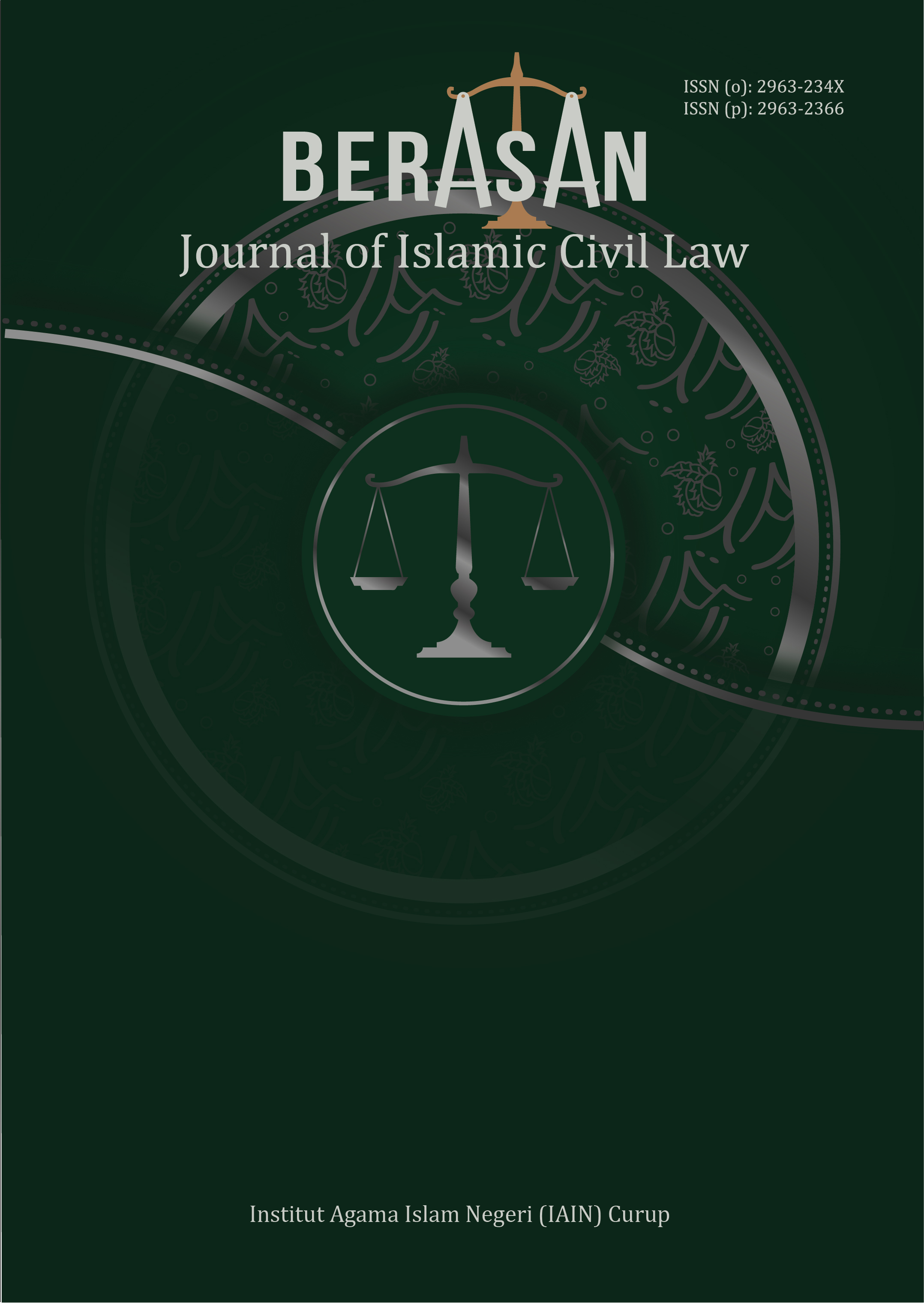Problematika Perkawinan Beda Usia Pada Masyarakat Kecamatan Cina Perspektif Hukum Islam
DOI:
https://doi.org/10.29240/berasan.v3i2.11816Keywords:
Age Difference, Islamic Law, Problem, MarriageAbstract
This research aims to determine the perspective of Islamic law regarding age difference issues in the Chinese District community and efforts to overcome the problem of age difference marriages in the Chinese District community. Research data was obtained by conducting qualitative field research using observation, documentation and direct interview data collection techniques with the community in Cina District. The research approach used is a normative theological and sociological approach. The results of the research show that the people of China District have varying views regarding age-gap marriage, where some support it on the grounds that age is not the only indicator of maturity and success in marriage, while others disagree because of the social stigma attached. From the perspective of Islamic law, this kind of marriage is considered valid as long as it meets the specified conditions and harmony, although the couple needs to overcome challenges arising from the age difference. The efforts made by the people of China District in overcoming the problems that arise in age-gap marriages are compromising on the expectations of each partner, looking for similar interests in each other, ensuring that values, morals and life goals are in accordance with each other, seeking social support, planning problem solving, using coping strategies in solving problems.
Downloads
References
Abd. Shomad, Hukum Islam, Jakarta: Kencana, cet. 2, 2012.
Ahmad Azhar Bazhir, Hukum Perkawinan Islam, Yogyakarta: Pustaka Pelajar Omsel 1996.
Ahmad Ghazaly, Langkah Menuju Keluarga Yang Harmonis, Jakarta: Gramedia Pustaka Utama, 2010.
Angraini, Ma’ruf dan Hasanuddin, Kompilasi Hukum Islam (KHI). Jakarta: Permata Press, 2003.
Angraini, Sintia. “Relasi Dan Keharmonisan Pasangan Perkawinan Beda Usia Ditinjau Dari Kompilasi Hukum Islam (Studi Kecamatan Curup Kabupaten Rejang Lebong)”. Skripsi, Fakultas Syariah dan Ekonomi Islam IAIN Curup, Curup, 2023.
Asman, "Dinamika Usia Dewasa dan Relevansinya Terhadap Batas Usia Perkawinan di Indonesia: Perspektif Yuridis-Normatif,” Journal of Islamic Law No.1 (2021), h. 119-137. http: // ejournal. iainptk. ac. id/ index. php/ jil/ article/ view/ 66
Azhaar Basyir, Ahmad, dkk., Keluarga Sakinah Keluarga Islami. Cet. 1; Yogyakarta: Pt. Kurnia Kalam Semesta, 1994.
Basri Rusdaya, “Konsep Perkawinan Dalam Pemikiran Fuqaha” Jurnal hukum Diktum, Vol. 13, No. 2. 2015.
Butsanah Sayyid al-Iraqy, Menyingkap Tabir Perceraian, Jakarta: Pustaka al Sofwa, 2005.
Darahim, Membina Keharmonisan Dan Ketahanan Keluarga, Jakarta Timur: IPGH,2015.Muhammad Iqbal, “Psikologi Ketahanan Keluarga” Jurnal Psikologi Universitas Mercu Buana, Vol.3, No.9. 2017.
Darajat Zakiah, Ilmu Fiqih, Yogyakarta, PT Dana Bhakti Wakaf.
Gestianto Prabowo, “Penyesuaian Perkawinan Pada Pasangan Suami Istri Yang Istrinya Berusia Lebih Tua Dari Suami di Purwokerto” (Skripsi, Universitas Muhammadiyah Purwokerto, Purwakerto 2017.
Helmawati, Pendidikan Keluarga, Bandung: Remaja Rosdakarya Offset, 2016.
Idain Muhammad, Pesan Pesan Rasulullah Untuk Membangun Keluarga Samara, Yogyakarta: Araska, 2015.
Isnu Harjo Prayitno, Edi Sofwan, Ibrohim “Konsep Ketahanan Keluarga Yang Ideal…h.74.
Isnu Harjo Prayitno, Edi Sofwan, Ibrohim “Konsep Ketahanan Keluarga Yang Ideal Untuk Menciptakan Keluarga Yang Tangguh Dan Sejahtera Di Kota Tangerang Selatan” Jurnal Pengabdian kepada Masyarakat Universitas Pamulang, Vol.1, No.2, 2021.
Mahmudin Bunyamin dan Agus Hermanto, Hukum Perkawinan Islam, Bandung: Pustaka Setia, 2017.
Meichiati, Membangun Keharmonisan Keluarga, Bandung: Alfabeta, 2014.
Moh. Ali Wafa, Hukum Perkawinan di Indonesia: Sebuah Kajian dalam Hukum Islam dan Hukum Materil, Tangerang: Yasmi, 2018.
Moh. Hatta, “Batasan Usia Perkawinan dalam Perspektif Ulama Klasik dan Kontemporer,” Al-Qanun No.1 2016, https://doi.org/10.15642/alqanun.2016.19.1.66-88
Moh. Muchtar Ilyas, Modul Pelatihan Keluarga Sakinah, Jakarta: Departemen Agama RI, 2007.
Mohammad Fauzil Adhim, Kado Perkawinan untuk Istriku, Yogyakarta: Mitra Pustaka, 2008.
Mulia Musda, Pandangan Islam Tentang Poligami, Jakarta: LKAJ&SP. 1999.
Muttaqien Dadan, Cakap Hukum Bidang Perkawinan dan Perjanjian, Yogyakarta: Insania Cita Pres, 2006.
Sitti Fatimah Nashar, Perbedaan Usia Pasangan Suami Istri Dan Relevansinya Pada Keharmonisan Rumah Tangga, Pemekasan: Duta Media Publishing, 2020.
Tihami dan Sohari Sahrani, Fikih Munakahat Kajian Fikih Nikah Lengkap. Jakarta: Rajawali Pers, 2014.
Zamroni Ishaq, “Diskursus Kepemimpinan Suami dalam Keluarga (Pandangan Mufasir Klasik dan Kontemporer),” Jurnal Ummul Qura No. 2, 2014, h. 24-26 http: //ejournal. kopertais4. Or .id /pantura/ index. php/ qura/ article/ view/ 2030.
Downloads
Published
Issue
Section
Citation Check
License
Copyright (c) 2025 Misnawati Zakfah, Sarina Sarina

This work is licensed under a Creative Commons Attribution-NonCommercial-ShareAlike 4.0 International License.
Authors who publish with Berasan: Journal of Islamic Civil Law agree to the following terms:
- Authors retain copyright and grant the journal right of first publication with the work simultaneously licensed under a Creative Commons Attribution-NonCommercial-ShareAlike 4.0 International License (CC BY-NC-SA 4.0) that allows others to share the work with an acknowledgment of the work's authorship and initial publication in this journal.
- Authors are able to enter into separate, additional contractual arrangements for the non-exclusive distribution of the journal's published version of the work (e.g., post it to an institutional repository or publish it in a book), with an acknowledgment of its initial publication in this journal.
- Authors are permitted and encouraged to post their work online (e.g., in institutional repositories or on their website) prior to and during the submission process, as it can lead to productive exchanges, as well as earlier and greater citation of published work (See The Effect of Open Access).









